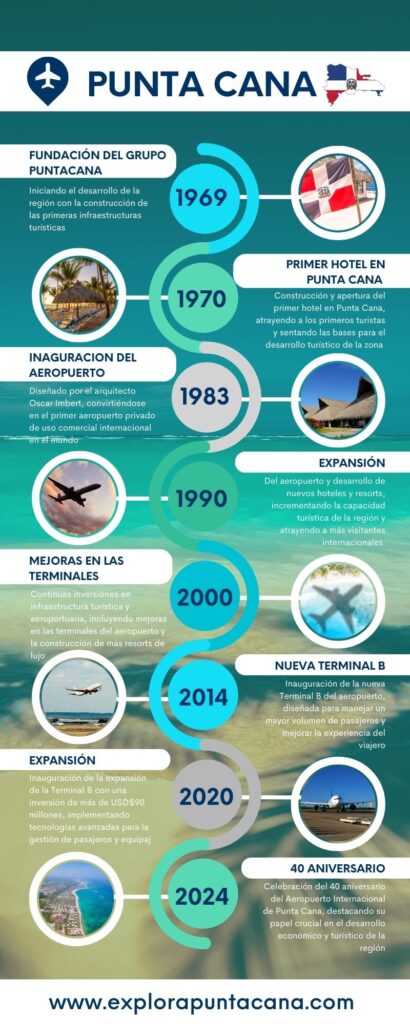Pillar of Regional Development
Have you ever wondered how a single airport can transform an entire region? The Punta Cana International Airport (PUJ) is not just a gateway to the paradise beaches of the Dominican Republic; it is an engine of economic, social, and cultural development that has redefined the Caribbean landscape. Since its inauguration, this airport has played a crucial role in tourism growth and local infrastructure improvement. Let's discover how this has been possible!
History and Evolution of Punta Cana International Airport
The Early Years

Punta Cana International Airport opened its doors in 1983 with modest infrastructure but a clear vision: to turn Punta Cana into a world-renowned tourist destination. Initially, operations were limited, and facilities were basic. However, from the beginning, the administration had an innovative mindset and a strong commitment to the future. In fact, if you ask Dominicans about the time when the airport opened, they will tell you that it was all “bush and snakes.”
Today, it couldn't be more different from those humble beginnings. PUJ has become an international benchmark, handling 68% of the country's tourist air traffic and connecting with 75 cities in 34 countries through 58 airlines. This airport moves over 9 million passengers and transports more than 25 million kilograms of cargo annually.
Expansion and Modernization
Over the years, the airport has undergone multiple expansion phases. In the 1990s, new terminals and runways were built, significantly increasing the capacity for flights and passengers. These improvements not only facilitated a greater flow of tourists but also attracted international investments and promoted the development of hotel and service infrastructure in the region.
Economic Impact of Punta Cana International Airport
Job Creation
One of the most notable impacts of Punta Cana International Airport has been job creation. Thousands of people work directly or indirectly at the airport, from airline staff to transport and commerce services. Additionally, the tourism boom has driven job creation in sectors such as construction, hospitality, and retail. The import and export of goods through the airport's cargo services have also contributed.
Investments and Real Estate Development
The airport has been a catalyst for significant investments in the region. Major hotel chains and real estate developers have seen the potential of Punta Cana and invested millions of dollars in building luxury resorts, shopping centers, and residential complexes. This investment has not only improved the quality of life for local residents but also attracted a middle-upper class and high-spending tourists.
The Airport's Role in Tourism
A Global Destination
Thanks to Punta Cana International Airport, the region has become a global destination. With direct flights from cities in Europe, North America, and Latin America, tourists can easily reach Punta Cana's beaches. This has made the region an attractive option for travelers worldwide, increasing the flow of visitors year after year.
The airport has 2 runways, 33 boarding gates, 38 aircraft parking positions, and 7 VIP lounges. This reaffirms its essential role in the region's socioeconomic growth and its commitment to the future.
Tourist and Cultural Activities
The ease of access provided by the airport has enabled the development of a wide range of tourist and cultural activities. From water sports to eco-tours and cultural events, visitors have countless options to enjoy. Additionally, the improved infrastructure has allowed the organization of international events, such as conferences and festivals, attracting even more visitors to the region.
Challenges and Future of Punta Cana International Airport
Sustainability and Environment
With growth comes responsibility. One of the challenges the airport faces is sustainability. The administration has implemented several initiatives to reduce environmental impact, such as recycling programs and the use of renewable energies. However, the increasing influx of tourists constantly challenges waste management and natural resource conservation.
Innovation and Technology
Terminal B, with an investment of over USD$90 million, is one of the most modern in the region, capable of handling 5,000 passengers per hour and 4 million passengers annually. This expansion includes seven boarding gates and air bridges, and it is expected to enable the airport to exceed 11 million passengers annually.
Looking to the future, the airport is investing in innovation and technology to improve the passenger experience. From advanced air traffic control systems to state-of-the-art facilities, the goal is to stay at the forefront and continue being a model of efficiency and comfort in the region.
Crecimiento Sostenido en el Caribe
Desde 2019, la República Dominicana ha sido el país con mayor crecimiento en llegadas de turistas en toda la región del Caribe. Pasó de recibir 6.4 millones de visitantes a más de 10 millones, consolidándose como el destino preferido en la recuperación del turismo post COVID-19. De estos 10 millones alrededor de 52% fue captado solo por en Aeropuerto Internacional de Punta Cana.
De acuerdo al Ministerio de Turismo de Republica Dominicana estos solo los principales países emisores de visitantes a Republica dominicana.
Conclusion
Punta Cana International Airport has been and continues to be a fundamental pillar in the region's development. Its impact goes beyond being a mere arrival and departure point; it is an economic, social, and cultural engine that has transformed Punta Cana into a world-class destination. With a focus on sustainability and innovation, the airport's future looks promising, ensuring it will remain a catalyst for regional growth for many years to come.
FAQs
- How has Punta Cana International Airport impacted the local economy?
The airport has generated thousands of direct and indirect jobs and attracted significant investments in hotel and commercial infrastructure.
- What types of flights does Punta Cana International Airport receive?
It receives direct international flights from cities in Europe, North America, and Latin America, facilitating access for tourists from all over the world.
- What sustainability measures has the airport implemented?
The airport has implemented recycling programs, renewable energy use, and other initiatives to reduce its environmental impact.
- How has technology improved at Punta Cana International Airport?
Investments have been made in advanced air traffic control systems and state-of-the-art facilities to enhance the passenger experience.
- What tourist activities can be enjoyed thanks to the airport?
Tourists can enjoy a wide range of activities, from water sports and eco-tours to cultural events and international festivals.
Visiting Punta Cana International Airport is not just the start of a vacation, it is an experience that connects the world with the beauty and hospitality of the region!











